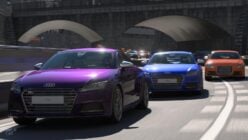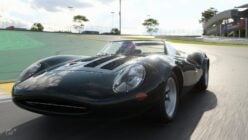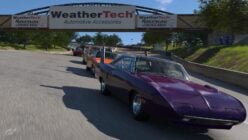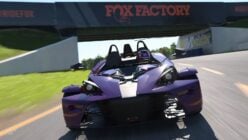Welcome to a new feature here at GTPlanet. In December 2015, Polyphony updated their website, including profiles on some of the personnel. These interviews shed some light on the people behind the scenes that make Gran Turismo what it is. We offer them here in translated form, which wouldn’t be possible without the generous efforts of community member Imari.
All images, unless otherwise noted, are care of Polyphony Digital Inc.
STAFF INTERVIEW 001: Norio Takama (Original interview here)
Moved from a game development studio to join Polyphony Digital in 1999. Involved in development from Gran Turismo 3 onwards. Handles numerical computation libraries, as well as character motion for the drivers and crowds.
The storefront of the electronics shop in my hometown was my classroom
I come from a town in Gunma. There was a small electronics store that had computers lined up near the entrance. On the way home from school, all the high schoolers would stop and play games or program. This was around the time when things like the MZ-80, PC-8000, and FM-7 were popular. At the time I was in the fourth or fifth year of primary school. I was really interested, so I used to stand behind them and watch what was going on.
One day I was playing a pachinko game, and suddenly it threw up a program screen. Somehow, just from watching I knew how to produce ASCII art in the code. I still remember the excitement that I felt when I overwrote where I thought the score was kept, and it was displayed on screen. After that, some of the older high school boys taught me BASIC, and I made some simple shooting games and the like.
The impact of Virtua Fighter
From junior high on I was very busy with club activities, student council and the like. I met a very interesting math teacher who made studying math a lot of fun, so I hardly touched computers at all. I moved to Tokyo to enter the mathematics course at Waseda University, and spent a lot of time going to watch pro wrestling, which I was really into.
When I was a child, I had met the first Tiger Mask** in person, and ever since I had been an enormous fan of pro wrestling. But when Virtua Fighter came out while I was at university, I found myself going to the arcades more and more. With my love of pro wrestling and martial arts, the way that the characters moved in the game really made sense to me.
**TL NOTE: There have been several wrestlers named Tiger Mask in Japanese pro wrestling. The first and the one that Mr. Takama is referring to was Satoru Sayama, who played the role from 1981 to 1983. Tigermask reference image provided by Imari.
A bank? Or game development?
As I was searching for a job, I found myself wondering what it was that I wanted to do. “Maybe a foreign exchange job where I could use my math skills”, was one of the thoughts that I had. I also remembered Virtua Fighter, and how much fun I had making games when I was younger. These two ideas were both appealing, and so I applied to both banks and game development studios. I decided that I should take the first offer that I got.
In the end, I got a job at the first game developer I applied for. I worked there for about two years. My mentor joined Polyphony before I did, and they convinced me to join them at Polyphony Digital.
The human body is the same whether it’s in a fighting game or riding a motorbike or driving a car
To start with I was dealing with software tools, but a few years later we put out a motorbike demo at E3. That was where I started moving into the rider movement. Afterwards I kept working with character motion. There were many popular methods, like motion capture, or using animators to create motion, but I wanted to generate all the movements in real time.
Because Gran Turismo has so many vehicles, to record all the motions of the driver would take a lot of resources. With the movement of the cars, I watched Akihiko Tan assemble the cars a piece at a time so that they could be simulated. So for the movement of the drivers I placed them in a traditional driving position, hands here, legs here, and so forth. Then I built up a system of how the joints could move, how the bones and muscles could move. The technique is called inverse kinematics.
The advantage of this is that once the position of all the bones is defined, it’s relatively easy to extrapolate motion from external forces. To me, the human body is the same whether it’s in a fighting game, or riding a motorbike, or driving a car. It’s an area that I continue to think about and investigate.
What makes Polyphony Digital special
After I joined Polyphony, my first thought was “At least there are a lot of people who are really good at their jobs”. The amount of knowledge that they all had was staggering. In one sense, it was quite disconcerting; at the time I didn’t understand when and how business decisions were made. But now I can see every work request and discussion that goes through the internal chat system, so I always understand what’s going on. The programmers can talk to the artists about what’s happening and any ideas they have, and vice versa.
After the earthquake in 2011, it was barely six months before we had an office running in Fukuoka, to spread our risk. “Always make the company better” and “Do what’s right for the company, right away” are both very strong sentiments within the corporate culture. A lot of the employees are married, and a lot of employees who have resigned have chosen to come back and work here again. I think these things demonstrate what sort of company it is.
How do you recruit Physics Engine Development Engineers?
The calculations for the physics engine in the game are restricted by time and resources. And all the while, the user will be adding inputs that cannot be predicted, so it’s a rather unique problem. A program that is stable at high speeds, yet realistic and conveys a good sense of balance is a must, and so experience with game development is a big plus.
On the other hand, things that aren’t possible on computers now may well be in another ten years, so I think that a good foundation in physics and mathematics as well as keeping up to date on relevant papers and articles is very important.
But look at me, I only knew mathematics. I stopped programming when I was in primary school until I started my game development job, and so I had to work really hard to overcome my limitations with regards to computers. I think that there’s a certain level of knowledge that is necessary to work here, but if you want to improve yourself then Polyphony is definitely an environment in which you can reach the very top. There has never been a time when I’ve asked a question about computers that somebody in the company hasn’t been able to answer.
Thank you to Imari for providing the translation!
See more articles on Polyphony Digital.









I’m looking forward for the next translation.
I’d like to know when the next update is coming out for GT6.
Its dead jim its dead.. bring on gt7
I’m a doctor, not a game developer!!
The effort that went into the translation is much appreciated, thanks Imari!
Interesting feature, too. A rare insight to the structure and “philosophy” of the organisation, and also into the tech.
Watching the in-car replays and the way the driver models jostle about is enough to be convinced that they are using IK in the game and not just in their content workflow.
I think they do use canned animations elsewhere, but these will vary as to their quality according to their importance and the artist.
In fact, if it’s a dodgy-looking animation, it probably is hand-authored and not simulated (ignoring the deliberate ham-stringing of the steering and gear change animations, which have worked better at various times in the past). That said, IK can be really weird, too; anyone remember that Jurassic Park Trespasser game? ;)
Please make drivers hands when shifting much quicker! They shift like 100yo grandpa. (either paddle or stick)
I knew it must have been him. After reading he does character/driver animations, I thought, ‘Was he a part of the small group of Tourist Trophy creators?’
Great staff, some dreams are reality from there!
Thanks Imari, and other folks who helped put this up. Really enjoyed reading this, looking forward to seeing more of PD soon. :D
This is awesome of you, Imari! Not often a person will suffer through an extended translation! I KNOW it isn’t an easy thing to do! Thank you very much!
Can’t wait for the next one! :)
This was great. Thank you for the translation. I thought I was going to have to learn some Japanese to read everything on PD’s website.
After reading the headling I tought “aha, so this is the guy who messed up GT6 driving physics (top speed physics), but after reading the article it seems that he is only responsible for ‘driver movement in the car’…? OK, then I won’t shout this time….but Kyle, I hope you get us the man who is responsible for the broken game that we got from them. Waiting for next articles…! :)
GT6 isn’t broken! Just could use a few small adjustments to offline gameplay.
Thanks Imari!! Nice touch adding in the photo of Tiger Mask…lol.
That was quite interesting. Eagerly waiting for the next one! :)
Thanks for the translation Imari!
Using google translate to read all the other bios is quite hilarious. Oh well…
Very interesting!
Amazing read.
Is nice to know some faces behind GT.
Thansk for the translation work, Imari!
There is mention of real time generated movements for the driver in the cars, I don’t think PD has implemented that in GT yet, their driver animations are usually very good. I see their simulate everything approach wasn’t just talk. Good to see an interview with one of the many minds behind the engine that is Gran Turismo.
Good read, a bit short but good none the less.
It’s probably in there considering that he’s discussing using it for Tourist Trophy, and discussing the advantages of using such a system because Gran Turismo has so many vehicles. That’s how he’s claiming that the driver animation system works, that it reverse engineers the movements of the rest of the skeleton by using the designated position of certain key points like hands and feet and some basic rules of how the joints and bones may move (the “simulation”). It reduces the amount of work the animators/artists have to do to define movement per car and allows the engine to do most of the heavy lifting after it’s been given some basic parameters.
Whether they actually simulate in real time on PS3 or simply use that engine to pre-generate “traditional” animations is probably a fair question, but he hasn’t mentioned it so I’d say that they probably just simulate in real time.
It’s probably also why zombie Jeff Gordon and zombie Sebastian Vettel move the way that they do, because they’re puppets being dragged around by their extremities. Ditto the moving spectators on some courses. It’s possible to do all the same stuff with traditional information, but if this “puppet” system is what they have rigged up then they might as well use it for as much as they can, and a lot of the character movement looks like it fits that paradigm pretty well.
It is nice to see the people making the games instead of dealing with just a brand or a P dept. Really cool feature.
Awesome. Thanks!!
Was this from their blogpage?
What happened to it by the way?
This is from their official website which got a major renovation a few weeks ago. The PitStop Blog is still here.
It’s nice seeing what goes on behind the scenes of a game this size. Big thanks to Imari for beating Google Translate’s gibberish.